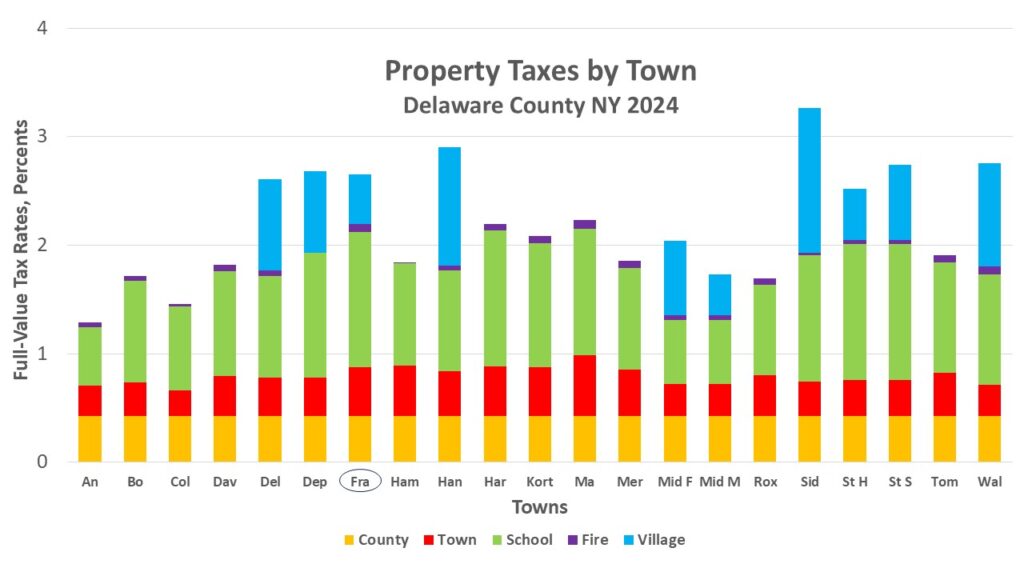Townspeople complain that we are paying too much in taxes. Adding together the taxes on your property going to county, town, school district, and fire district, we pay at the second highest rate in the county. Landowners in the village or hamlet pay even more.

County
In 2024, Delaware County levied a tax on property in the 19 towns totaling $35.8 million. To collect this, the full-value tax rate was 0.43% of the assessed market value of property. Of the 57 counties in New York, that was the 36th highest. (Not included are the five boroughs of New York City.) Rates in our neighboring counties ranged widely, with Chenango (0.87%) having twice the rate as we do, and our having twice that of Otsego (0.24%). Delaware County was better than average, with a rate well below the median. Typically, those taxing at a lower rate are the more urban counties with more valuable real estate to tax, aka a larger tax base. However, our tax rate was below that of richer Broome (0.58%) and Sullivan (0.55%). The Delaware County Board of Supervisors is doing a comparatively good job of keeping our property tax low. County tax is collected on the town bills.
Town
The rate for Franklin township was higher than most. Last year, the town board levied a tax of $1.39 million on 2,207 parcels of which 2,104 were taxable.
Looking at the 19 towns in Delaware County, almost all had full-value property taxes between 0.28 and 0.47%. The outliers were Colchester at 0.23% and Masonville at 0.56%. Franklin had a full-value tax rate of 0.45%, which is the 4th highest in the county after Masonville, Hamden, and Harpersfield. Colchester’s rate was about half that of Franklin’s. Even Sidney’s was a third less than ours. Also, two neighboring towns in Otsego had a lower rate, with Unadilla at 0.34% and Otego at 0.42%.
School District
Last year, Franklin Central School district collected more than twice as much taxes as the town at $3.15 million.
A comparison throughout the county is not practical because school districts cross town boundaries. Smaller districts such as Deposit and Hancock cover three towns, whereas the largest, Margaretville, sprawls across eight towns. Enrollment in the Franklin Central School district includes about 16% of students from Davenport, Meredith, Otego, Sidney, and Walton.
There are 66 separate school/town rate combinations in the county. Here we look at just the rate that applies to most of each town.
Of the dozen school districts in Delaware County, Andes had the lowest tax rate at 0.53% and Stamford the highest at just over 1.25%. Landowners in the Franklin school district paid the 2nd highest at slightly less than 1.25%. Those in the town of Franklin but in the district of Delaware Academy received a significant break at 0.94%, a third less. Smaller areas of our town are in the school districts with lower rates: Sidney (1.16%) or Walton (1.02%).
This high rate is not due to the high levy – FCS district had the second smallest in the county, almost tied with lowest, Andes, at $3.12 million. The problem is that our district has such a small tax base at $253M, the smallest in Delaware County by far. It is about half the size of the two next smallest school districts of Hancock ($450M) and South Kortright ($452M).
Landowners of Franklin paid $3.6 million in property taxes to all the school districts. Almost $0.73M (20%) of that goes to Delaware Academy. (A quarter of the Town of Franklin is in the DA school district, but it contributes only 7% of that district’s enrollment.) Franklinites paid smaller amounts to Walton district (5%) and Sidney (1%). The lion’s share goes to Franklin district at $2.6M (72%).
Flipping the script, the tax levy made up $3.15M (40%) of the budget for the Franklin School District in 2024. Contributions to this were from residents of town of Davenport $0.18M (6%), Franklin $2.64M (84%), Meredith $0.15M (5%), Otego $0.02M (1%), Sidney $0.11M (3%), and Walton 0.05M (1%).
Looking at the nets, FCS gained $0.51M from landowners in other towns, whereas other school districts were paid $0.96M from landowners in the Town of Franklin.
Fire District
Low by comparison to other demands, the fire district taxed Franklin landowners only $0.24 million or $236 thousand.
The tax levy for fire departments make a smaller contribution to our overall tax burden. In Franklin, it is about a sixth the size of the county or town levies and a sixteenth the size of the school’s. Nevertheless, as with the school rate, the Franklin fire rate was the 2nd highest in the county at 0.076%. (In a few towns, fire departments receive some or all money directly from the town budget: Colchester, Deposit, Hamden, Harpersfield, and Sidney.) Franklin levy pays for two departments.
Fire department tax is collected on the town bills.
For a total burden of property taxes from county, town, school, and fire, town of Franklin outside of the village had the 2nd highest rate at 2.20%. This was just below that of the much smaller Masonville, by only 0.03%. That town has the smallest tax base in the county, half the size of ours. In contrast, the lowest total rate was Andes at 1.29%. Those Franklin landowners in the Delaware Academy school district got a considerable break with a total rate of 1.89%.
Village and Special Districts
The tax rates for the ten villages in Delaware County ranged widely from 0.38% for Margretville to 1.33% for Sidney. The village of Franklin had the 3rd lowest rate at 0.45%. Because of its small size and small business district, the village tax base is the smallest in our county at $22.3 million. The village budget was financed with $0.10 million ($101 thousand) in property taxes.
Many towns have special tax districts that collect a tax levy from only those landowners within that district. For example, in Delaware County there are 21 hamlets with water districts. Treadwell Water District collected $12 thousand. Also, half the school districts have a small levy for the library, which for the Franklin Free Library was $41 thousand.
Water district tax is collected on the town bills, whereas library tax is collected on the school bills.
The less prosperous towns tend to be the ones with the higher tax rates because they finance their budgets from a smaller tax base. While the more prosperous towns do more, there are basic services that all towns must provide. Franklinites have to pay for a large road system, to draw from a small school district, and to finance two fire departments.
